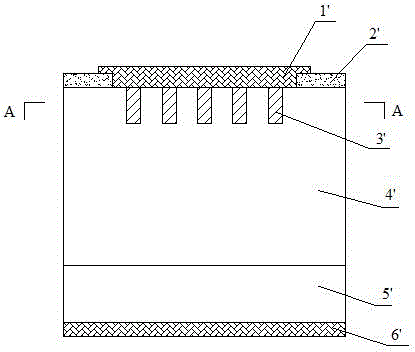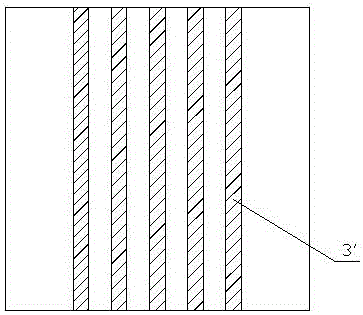SiC annular floating-point type P+ structured junction barrier Schottky diode and preparation method thereof
A junction-barrier Schottky and floating-point technology, used in semiconductor/solid-state device manufacturing, electrical components, circuits, etc. The effect of conducting conduction current, increasing conduction path, and increasing contact area
- Summary
- Abstract
- Description
- Claims
- Application Information
AI Technical Summary
Problems solved by technology
Method used
Image
Examples
Embodiment 1
[0041] Step 1, such as Figure 5 As shown, the N-drift layer is epitaxially grown on the N+ silicon carbide substrate: first, the N+ type silicon carbide substrate 5 is cleaned by RCA standard; , Nitrogen ion doping concentration is 5×10 15 cm -3 N - For the epitaxial layer 4, the epitaxial process conditions are as follows: the temperature is 1580° C., the pressure is 100 mbar, the reaction gas is silane and propane, the carrier gas is pure hydrogen, and the impurity source is liquid nitrogen.
[0042] Step 2, such as Image 6 As shown, a ring-shaped floating-point type P+ implantation region 3 is formed on the N- epitaxial layer: (2.1) Deposit 2 μm of SiO 2 As a barrier layer for Al ion implantation in the P+ implantation area, and form the implantation window of the ring-shaped floating-point P+ implantation area 3 by photolithography and etching; (2.2) Perform aluminum ion implantation three times at a temperature of 400 ° C, and the The doses were 1.33×10 14 cm -2 ...
Embodiment 2
[0047] Step 1, such as Figure 5 As shown, the N-drift layer is epitaxially grown on the N+ silicon carbide substrate: first, the N+ type silicon carbide substrate 5 is cleaned by RCA standard; , nitrogen ion doping concentration is 1×10 15 cm -3 The epitaxy process conditions of the N- epitaxial layer 4 are as follows: the temperature is 1580° C., the pressure is 100 mbar, the reaction gas is silane and propane, the carrier gas is pure hydrogen, and the impurity source is liquid nitrogen.
[0048] Step 2, such as Image 6 As shown, a ring-shaped floating-point type P+ implantation region 3 is formed on the N- epitaxial layer: (2.1) Deposit 2 μm of SiO 2 As a barrier layer for Al ion implantation in the P+ implantation area, the implantation window of the ring-shaped floating-point P+ implantation area 3 is formed by photolithography and etching; (2.2) Perform aluminum ion implantation three times at a temperature of 500 ° C, implant The doses were 1.33×10 14 cm -2 , 8.2...
Embodiment 3
[0053] Step 1, such as Figure 5 As shown, the N-drift layer is epitaxially grown on the N+ silicon carbide substrate: first, the N+ type silicon carbide substrate 5 is cleaned by RCA standard; , nitrogen ion doping concentration is 2×10 15 cm -3 The epitaxy process conditions of the N- epitaxial layer 4 are as follows: the temperature is 1580° C., the pressure is 100 mbar, the reaction gas is silane and propane, the carrier gas is pure hydrogen, and the impurity source is liquid nitrogen.
[0054] Step 2, such as Image 6 As shown, a ring-shaped floating-point type P+ implantation region 3 is formed on the N- epitaxial layer: (2.1) Deposit 2 μm of SiO 2 As a barrier layer for Al ion implantation in the P+ implantation area, the implantation window of the ring-shaped floating-point P+ implantation area 3 is formed by photolithography and etching; (2.2) Perform aluminum ion implantation three times at a temperature of 400 ° C, implant The doses were 1.33×10 14 cm -2 , 8.2...
PUM
 Login to View More
Login to View More Abstract
Description
Claims
Application Information
 Login to View More
Login to View More - R&D
- Intellectual Property
- Life Sciences
- Materials
- Tech Scout
- Unparalleled Data Quality
- Higher Quality Content
- 60% Fewer Hallucinations
Browse by: Latest US Patents, China's latest patents, Technical Efficacy Thesaurus, Application Domain, Technology Topic, Popular Technical Reports.
© 2025 PatSnap. All rights reserved.Legal|Privacy policy|Modern Slavery Act Transparency Statement|Sitemap|About US| Contact US: help@patsnap.com



